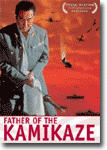 |
|
|||||||||||||||||||||||||||||||||||||||||||||||||||||||||||||
Since my exposure to World War Two films has largely been from the Western vantage, it was interesting to see an epic WWII film made by and for a Japanese audience. However, like many epic films (not my favorite genre), this film tends to be to broad in scope in its efforts to be epic and takes a story it could have told effectively in about two hours and instead spreads it out over a seat-numbing 3 hours and 20 minutes. The story: foreseeing inevitable defeat, respected Naval officer Onishi Takijiro (who initially opposed the alliance with Nazi Germany and Fascist Italy), concocts a radical strategy to force MacArthur's forces to perhaps consider a negotiated peace (at this point in the war, a draw would be considered a "victory" for Japan). His plan: the now legendary and fearsome kamikaze attacks, in which a Japanese pilot would make a suicide dive, his plane loaded with explosives, into ships into the American fleet. The film goes to great pains to show that Onishi by no means took the required loss of life for his pilots lightly. However, he was well aware of the difference in culture and of thinking between the Japanese soldier and the Western one. Whereas the West would base their military strategies around estimated casualty numbers (and might postpone a mission if the expected casualty number were too high), for a Japanese soldier, death was far preferable to the shame of being captured - and death while vanquishing many of the enemy was an honorable way to die. The first few kamikaze missions caught the American and British forces off guard and were a success. However, the film notes that the Allies were quickly able to adapt and the success rate of kamikaze missions was halved rather quickly. From this point on, the missions - indeed the entire war campaign - are lost, and any battles are only delaying the inevitable. There are two major flaws in this film, one instantly forgivable, the other less so. The forgivable one: obviously, a non-Hollywood film from 1974 would have a limited budget and no CGI-effects to rely on. Thus, the battle scenes in this film are primarily a mix of actual war footage coupled with ineffective flying scenes using small-scale aircraft models. Though not terrible, the scenes with the models are rather obvious. Less forgivable is the way the film drags out. At the 1-hour 10-minute mark, the film notes that the effectiveness of the attacks has died and that the war is for the most part lost. What is left of the Japanese forces is shipped back to the homeland, where the film notes the ravages on the economy and population (Onishi visits his wife, who is making tea in the rubble of what was once their home, and he apologizes to his neighbors for not being able to protect them). At about the two-hour mark, the film notes when the atomic bombs are dropped by the Americans, plus Russia invades Japan's territories in Manchuria. The war is lost. For most of the last hour, the film basically repeats the same scene: either Onishi or one of his most rabid followers begs or challenges superiors not to surrender to the Americans. For nearly all Japanese, the thought of surrender was unthinkable and shameful, but particularly for Onishi (the thought of his pilots dying for a lost cause became unbearable). When the superior refuses their request, Onishi or the follower breaks down crying or goes into a rage. Seeing this same scene over and over becomes not only depressing but tedious. When the inevitable tragic (and very bloody) ending does finally occur, the viewer might feel more relief than sadness. Father of the Kamikaze Extras:
|
|
|||||||||||||||||||||||||||||||||||||||||||||||||||||||||||||
|
||||||||||||||||||||||||||||||||||||||||||||||||||||||||||||||
| action | animation | art house/international | comedy | documentary | drama | family | horror/sci-fi | suspense | television | ||||||||||||||||||||||||||||||||||||||||||||||||||||||||||||||
| contact | home | ||||||||||||||||||||||||||||||||||||||||||||||||||||||||||||||


